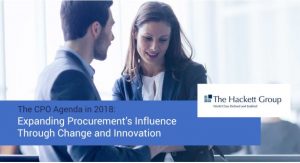Ivalua Named A Leader In The 2025 Gartner Magic Quadrant™ For Source-To-Pay Suites Report
View Report
Ivalua Named A Leader In The 2025 Gartner Magic Quadrant™ For Source-To-Pay Suites Report
View Report
Blog »

The latest Hackett Report “The CPO Agenda in 2018, Expanding Procurement’s Influence through Change and Innovation ” has just been released. The report confirms the challenges Procurement leaders face as well as the strategies they plan to employ to address them. Business risk is rapidly rising, in traditional areas such as access to talent, increased competition and regulation. Even more so from relatively new areas, namely cyber security. While cost reduction remains a highly ranked business and Procurement initiative, other business and Procurement initiatives continue to rise.
Procurement Challenges in 2018
Chief Procurement Officers who responded rated support for a broad base of objectives as important but also rated their ability to address most as low. The survey also confirms that they can’t count on increased resources to address the challenge.
“Procurement organizations need to evolve to meet the demands of a rapidly changing business environment, but must live with reductions in operating budgets averaging 0.3% in 2018.”

To meet the growing risk of objectives and enable companies to thrive in today’s highly uncertain market, Procurement leaders must evolve their organizations. They must become smarter, freeing capacity for more strategic work. In addtion, they must leveraging information better to make more informed and timely decisions. Also, they must better measure Procurement’s performance and value contribution. They must become more agile, to drive digital transformation initiatives and adjust to a rapidly evolving market.
Procurement must become more collaborative. 74% of respondents noted the importance of obtaining more value from existing supplier relationships, including driving supplier led innovation. That requires a deep level of collaboration. A great example is MBf Holdings, in Malaysia. MBf Holdings, effectively engaged its supply chain to develop a new offering. In doing so, they retained an at-risk customer. The pay back was, they created significant upsell opportunities for its sales force. It wasn’t easy – but it has enabled them to snatch victory from the jaws of defeat and drive top line growth.
Human Resource vs Technology
There are 2 key elements to the required transformation, a human one and a technological one. Technology is becoming an ever important enabler. However, successful adoption and application of that technology is only possible with the right talent. Procurement leaders must up skill their organizations. Access to critical talent was assessed as a high risk by 74% of respondents, up drastically from 43% the year prior. Procurement wants to develop and pay a more pivotal role in organisations. It also wants to become the trusted adviser that Hackett mentions in the report. To achieve this, Procurement knows it needs to put its house in order. In an article published in Supply Chain World Magazine, Swissport’s SVP and Group CPO Marianna Zangrillo quotes a frightening statistic –
70% of the current procurement resources won’t be able to do what Procurement will need to do as the world moves forward.

To address this Hackett finds that leading Procurement organizations, and 28% of the respondents, are looking outside. They are recruiting from new non-traditional, skills like physicists and data scientists into the Procurement area. This makes sense, as the requirement shifts up a gear. CPOs have aspirations to deliver more value to the board in its decision-making and future planning processes. Such a new look at talent is critical to supporting digital transformation, a key priority for organizations.
The partnership between Procurement and Technology
To empower this talent, Procurement is investing heavily in technology. The survey found drastic increases in projected use of mainstream technologies. Among these are Cloud-based applications, data visualization tools, master data management technologies and advanced analytics. It also found a meaningful percentage of organizations piloting new technologies such as Artificial Intelligence (31% of organizations).
The combination of mainstream technologies and new innovations is an important strategy. Let’s take artificial intelligence (AI) as an example. As the report notes, it offers tremendous potential to improve data classification and recognition. AI yields a new understanding
of relationships between disparate sets of data and helping organizations make faster,
more profitable business decisions. Yet it is ultimately constrained by data quality and access. Without a unified data model that spans both Source-to-Pay (S2P) and back end systems, AI cannot effectively link disparate information on a supplier. Mainstream technologies such as integrated S2P suites and vendor master management solutions can build a solid base upon which AI can maximize impact. The latest technologies must be deployed while simultaneously addressing fundamental challenges, especially when it comes to data.
CPO Challenges in 2018
2018 presents an ever growing list of challenges and risk that Procurement must deal with. Yet, this challenge implies that the opportunity to expand Procurement’s influence and establish the function as a trusted business advisor has never been greater. Procurement leaders are increasingly embracing a new approach to talent and innovative technologies that will serve them well in 2018 and well beyond.
To read the report in full (gated) – please click here
For more information on Ivalua, please visit www.ivalua.com, or follow us on @ivalua